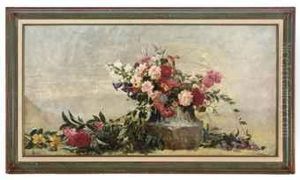L. Glaize Paintings
Léon Glaize (1842–1931) was a notable French painter and illustrator, recognized for his contributions to the academic and decorative arts during the late 19th and early 20th centuries. Born in Montpellier, France, Glaize developed an early interest in art, nurtured by his father, who was a painter and art teacher. This familial environment steeped in artistic tradition and technique provided a solid foundation for his future career in the arts. Glaize pursued formal education at the École des Beaux-Arts in Paris, where he studied under notable artists such as Alexandre Cabanel, a leading figure of the French academic painting.
Throughout his career, Léon Glaize's work was characterized by a meticulous attention to detail and a predilection for themes drawn from mythology, history, and allegory. His paintings often depicted scenes with a rich narrative quality, imbued with a sense of romanticism and classical beauty that was typical of the academic art tradition of his time. Glaize was also known for his portraiture, capturing the likeness and personality of his subjects with sensitivity and depth.
In addition to his painting, Glaize contributed significantly to decorative arts, undertaking commissions for murals and ceiling paintings in public buildings and private residences. His work in this area is distinguished by its elaborate compositions and vibrant use of color, which complemented the architectural spaces they adorned.
Glaize's contributions to the art world were recognized during his lifetime with several awards and honors, and he exhibited his work at important venues, including the Paris Salon, an annual art exhibition in France that was the premier event of the French art world. Despite the changing artistic trends of his time, including the rise of Impressionism and Post-Impressionism, Glaize remained committed to the academic style, emphasizing classical ideals of beauty and technical precision.
After his death in 1931, Léon Glaize's legacy continued through the appreciation of his works in museums and private collections. His dedication to the academic tradition provides an important insight into the artistic debates and developments of his era, reflecting the tension between tradition and innovation that characterized the late 19th and early 20th centuries in European art.
